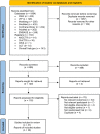Does tai chi improve psychological well-being and quality of life in patients with cardiovascular disease and/or cardiovascular risk factors? A systematic review
- PMID: 34983493
- PMCID: PMC8725570
- DOI: 10.1186/s12906-021-03482-0
Does tai chi improve psychological well-being and quality of life in patients with cardiovascular disease and/or cardiovascular risk factors? A systematic review
Abstract
Background: Psychological risk factors have been recognised as potential, modifiable risk factors in the development and progression of cardiovascular disease (CVD). Tai Chi, a mind-body exercise, has the potential to improve psychological well-being and quality of life. We aim to assess the effects and safety of Tai Chi on psychological well-being and quality of life in people with CVD and/or cardiovascular risk factors.
Methods: We searched for randomised controlled trials evaluating Tai Chi for psychological well-being and quality of life in people with CVD and cardiovascular risk factors, from major English and Chinese databases until 30 July 2021. Two authors independently conducted study selection and data extraction. Methodological quality was evaluated using the Cochrane Risk of Bias tool. Review Manager software was used for meta-analysis.
Results: We included 37 studies (38 reports) involving 3525 participants in this review. The methodological quality of the included studies was generally poor. Positive effects of Tai Chi on stress, self-efficacy, and mood were found in several individual studies. Meta-analyses demonstrated favourable effects of Tai Chi plus usual care in reducing anxiety (SMD - 2.13, 95% confidence interval (CI): - 2.55, - 1.70, 3 studies, I2 = 60%) and depression (SMD -0.86, 95% CI: - 1.35, - 0.37, 6 studies, I2 = 88%), and improving mental health (MD 7.86, 95% CI: 5.20, 10.52, 11 studies, I2 = 71%) and bodily pain (MD 6.76, 95% CI: 4.13, 9.39, 11 studies, I2 = 75%) domains of the 36-Item Short Form Survey (scale from 0 to 100), compared with usual care alone. Tai Chi did not increase adverse events (RR 0.50, 95% CI: 0.21, 1.20, 5 RCTs, I2 = 0%), compared with control group. However, less than 30% of included studies reported safety information.
Conclusions: Tai Chi seems to be beneficial in the management of anxiety, depression, and quality of life, and safe to practice in people with CVD and/or cardiovascular risk factors. Monitoring and reporting of safety information are highly recommended for future research. More well-designed studies are warranted to determine the effects and safety of Tai Chi on psychological well-being and quality of life in this population.
Systematic review registration: International Prospective Register for Systematic Reviews (PROSPERO), CRD42016042905. Registered on 26 August 2016.
Keywords: Anxiety; Cardiovascular disease; Depression; Quality of life; Stress; Tai Chi.
© 2021. The Author(s).
Conflict of interest statement
As a medical research institute, NICM Health Research Institute receives research grants and donations from foundations, universities, government agencies, individuals, and industry. Sponsors and donors also provide untied funding for work to advance the vision and mission of the Institute. The authors declare no competing financial interests.
Figures
Similar articles
-
Does Tai Chi improve psychological well-being and quality of life in patients with cardiovascular disease and/or cardiovascular risk factors? A systematic review protocol.BMJ Open. 2017 Aug 18;7(8):e014507. doi: 10.1136/bmjopen-2016-014507. BMJ Open. 2017. PMID: 28821509 Free PMC article.
-
Tai Chi exercise for psychological well-being among adults with cardiovascular disease: A systematic review and meta-analysis.Eur J Cardiovasc Nurs. 2020 Oct;19(7):580-591. doi: 10.1177/1474515120926068. Epub 2020 Jun 9. Eur J Cardiovasc Nurs. 2020. PMID: 32515204
-
The effects of Tai Chi on quality of life of cancer survivors: a systematic review and meta-analysis.Support Care Cancer. 2019 Oct;27(10):3701-3716. doi: 10.1007/s00520-019-04911-0. Epub 2019 Jun 24. Support Care Cancer. 2019. PMID: 31236699
-
Active mind-body movement therapies as an adjunct to or in comparison with pulmonary rehabilitation for people with chronic obstructive pulmonary disease.Cochrane Database Syst Rev. 2018 Oct 10;10(10):CD012290. doi: 10.1002/14651858.CD012290.pub2. Cochrane Database Syst Rev. 2018. PMID: 30306545 Free PMC article.
-
Effect of Tai Chi-Based Psychosomatic Rehabilitation Exercise on Physiological Function and Mental Health of Patients with Coronary Heart Disease: A Meta-Analysis.Rev Cardiovasc Med. 2024 Jun 24;25(6):227. doi: 10.31083/j.rcm2506227. eCollection 2024 Jun. Rev Cardiovasc Med. 2024. PMID: 39076332 Free PMC article.
Cited by
-
Exercise rehabilitation for patients undergoing interventional treatment for heart valve disease: a scoping review and evidence summary.BMC Nurs. 2025 Jul 21;24(1):950. doi: 10.1186/s12912-025-03603-x. BMC Nurs. 2025. PMID: 40691588 Free PMC article.
-
Global research on Chinese martial arts (1974-2025): A bibliometric and visualization-based analysis using Web of Science.Medicine (Baltimore). 2025 Aug 8;104(32):e43769. doi: 10.1097/MD.0000000000043769. Medicine (Baltimore). 2025. PMID: 40797508 Free PMC article.
-
Effects of exercise interventions on cognitive function in patients with cognitive dysfunction: an umbrella review of meta-analyses.Front Aging Neurosci. 2025 May 16;17:1553868. doi: 10.3389/fnagi.2025.1553868. eCollection 2025. Front Aging Neurosci. 2025. PMID: 40454205 Free PMC article.
-
Stress reduction through taiji: a systematic review and meta-analysis.BMC Complement Med Ther. 2024 Jun 3;24(1):210. doi: 10.1186/s12906-024-04493-3. BMC Complement Med Ther. 2024. PMID: 38831412 Free PMC article.
-
Perceptions of Participants on Trial Participation and Adherence to Tai Chi: A Qualitative Study.Patient Prefer Adherence. 2022 Sep 28;16:2695-2707. doi: 10.2147/PPA.S380780. eCollection 2022. Patient Prefer Adherence. 2022. PMID: 36196067 Free PMC article.
References
-
- Cardiovascular diseases (CVDs) [https://www.who.int/news-room/fact-sheets/detail/cardiovascular-diseases-(cvds)].
-
- Olga K, Diana P, Alyssa L. Projections of cardiovascular disease prevalence and costs: 2015-2035 (technical report) In: American Heart Association; 2016.
-
- Bittner V. The new 2019 AHA/ACC guideline on the primary prevention of cardiovascular disease. Circulation. 2020;142(25):2402–2404. - PubMed
Publication types
MeSH terms
LinkOut - more resources
Full Text Sources


